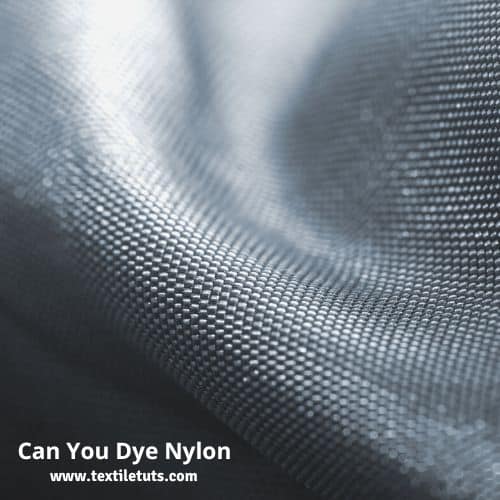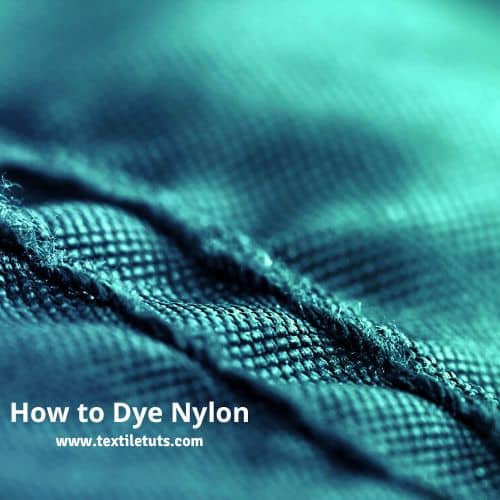How to Dye Nylon or Polyamide?
Among all the synthetics, Nylon is one of the strongest fibers which exhibit superb luster. Its capacity to hold moisture is another factor that makes it perfect for apparel applications. And this moisture-holding capacity also makes it easily dyeable at boil. If you’re wondering how to dye nylon effectively, then continue reading because we’ll explore all the routes of doing so.
But before that, we’ll give a brief introduction to nylon. If you’re not interested you can skip this part.
What is Nylon?
Where Do We Use Nylon?
It is a very versatile fiber and not only used in the textile but also have some industrial application. Generally, it is used to manufacture clothes, carpets, and tires. The significant uses in the textile industry are blouses, hosiery, lingerie, underwear, swimsuit, raincoats, etc. There is a lot of use in home furnishing, including curtains, bedspreads, carpets, upholstery, etc.
The industrial application of nylon are hoses, conveyor belts, seat belts, tire cord, racket strings, tents, sleeping bags, nets, threads, etc.
Can You Dye Nylon?
Now, let’s get to our main point, i.e., can you dye nylon. It can be dyed using acid dyes and also disperse dyes. Both of the dyes are entirely different from each other. To dye nylon with both of the dyes, heat is mandatory.

So, if you select blends containing nylon with other fiber like nylon/lycra blends, you have to be aware and careful. As Lycra is heat sensitive and may deform in the presence of heat, you must avoid putting stress on those materials. And the temperature limit should also be mentioned in the care label to prevent unwanted deformation.
If nylon is coated with Teflon, it will become water repellant. So, it will not absorb any water, and dyeing can’t be carried out.
How to Dye Nylon

Nylon can be dyed using many different processes. You can choose whatever seems convenient to you.
1. Nylon Dyeing with Acid Dyes Like Wool
- Firstly, if you mix several dyes to create a hue in nylon exactly the same as wool, unfortunately, it will not. You can know from the dye supplier about the properties of acid dyes, whether it will discharge on nylon poorly or well. But most of the time, they work well with acid and heat.
- The dye is dissolved in water with salt in the required amount of water according to the recipe.
- Then the material is added to the solution, and heating is carried out for ten minutes.
- Later vinegar is added, and heating is also continued for another ten minutes.
- Then the temperature is cooled gradually, and rinsing is carried out.
2. Tie Dyeing Nylon
There are various tie dye techniques that you can implement on Nylon. It is done with acid dyes.
- First, the material to be dyed is pre-soaked into acid.
- Tie the material according to the requirement.
- Then dye is dissolved in a solution, and materials are immersed into it.
- Heating is carried out with the help of a heater or microwave. It is done according to the recipe for a certain amount of time.
- Cooling of the materials.
- Finally, rinsing of the material.
3. Nylon Dyeing with Fiber Reactive Dyes
Generally, we all know that fiber reactive dyes are applicable to cotton and not applicable to nylon. But if you treat a reactive dye just like acid dyes, it will be applicable to nylon.
In this process, acid is used with heating, and fiber reactive dyes act as acid dyes as a recipe of acid dyeing is followed. The paler shade is produced when nylon is dyed with Procion MX dyes when compared to silk. There is a thing of concern. If you dye nylon in this process keeping alkaline pH (with soda ash in place of acid), nylon will either not be dyed or obtain a temporary color.
4. Nylon Dyeing with All-Purpose Dye and Multipurpose Dye
Using Rit All-purpose dye, it is possible to dye natural fibers such as cotton, silk, wool as well as synthetic fibers such as rayon and nylon. Both direct dye and leveling acid dye are present in Dylon’s Multipurpose dye. So nylon can be easily dyed with it.
And there is another thing of concern. That is, the direct dye portion of the multipurpose dye will not be of any use as the direct dye has no affinity towards nylon. So, it can be easily said that it is a waste of money. Sometimes if you are in an emergency situation and you have only these kinds of dyes available, you can use them.
5. Nylon Dyeing with Natural Dyes
A lot of natural dyes available, which are chemically acid dyes. So, in acidic conditions created by vinegar or citric acid, it is possible to dye nylon using natural dyes. An intense red shade with a slight brownish tone is obtained dyeing with cochineal by mordanting with alum. A golden yellow shade is produced in nylon by another natural dye, Turmeric, whether it pre-mordanting is done or not.
As synthetic fiber has less internal spaces like natural fibers, indigo dyes do not perform well in nylon. The soluble dye molecules find no spaces to get inside (penetrate) the fiber pores and so can not get trapped inside the pores after oxidation.
6. Nylon Dyeing in the Discharging Process
As hypochlorite causes severe damage to nylon during discharging, it should not be used. It can be done by an alternative chemical called Sodium Formaldehyde Sulfoxylate.
7. Nylon Dyeing with Disperse Dyes
The main problem of dyeing nylon with acid dyes is baree. Due to poor migration properties of acid dyes, dye molecules are unable to dye filaments with physical and chemical variations evenly, although they produce excellent washing fastness. This problem is eradicated by using disperse dyes which have superior migration properties.
Although the application of acid dyes is only limited to pale shades as they have poor to moderate wash fastness properties for dark shades. And also, the application is limited to fabrics that do not require severe washing during their uses. Another disadvantage is that Nitrogen oxide and ozone make nylon fade. Although another main advantage is using disperse dye application is easy and economical.
An exciting way of disperse dye application on nylon is using special rubber stamp pad ink of disperse dye, paints, and Crayons. With it, ironing-on pictures are prepared on paper. This method allows for creative freedom and unique, vibrant designs to be transferred onto nylon fabric. By experimenting with different products, artists can identify the best paint for clothing designs to achieve long-lasting and bold results. Additionally, the process is both accessible and versatile, making it suitable for professionals and hobbyists alike.
Nylon Dyeing vs Polyester Dyeing
Now, we’ll leave with an interesting fact, which we’ve already touched on slightly. Have you ever thought, despite being stronger than polyester, why Nylon can be dyed at boil, whereas polyester requires 135ºC (without carrier)?
It’s that 4% moisture regain that nylon has compared to polyester’s 0.4%.
In other words,
Water acts as a lubricant or carrier for Nylon
That’s why polyester fabric dye needs more energy to penetrate into the polyester fibers.
Well, that’s all for today. We hope after reading this article, you will be articulate a good answer if someone asks you how to dye nylon.
REFERENCES
